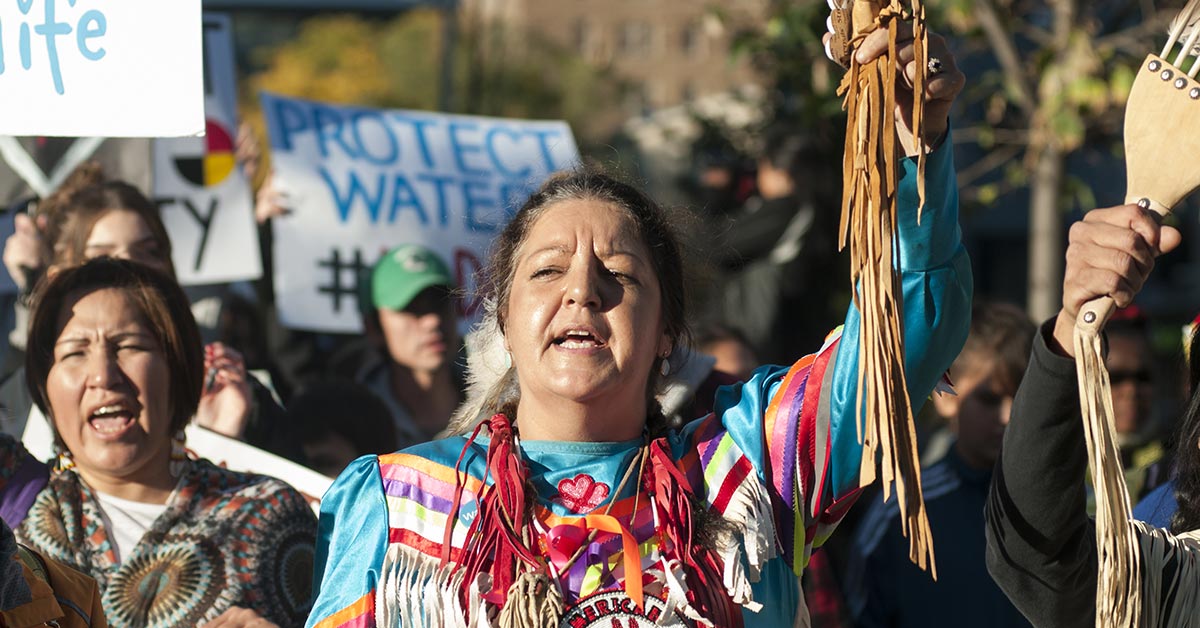End of the Line: The Women of Standing Rock is a documentary created by humanitarian and filmmaker Shannon Kring. It captures the story of a small group of Indigenous women who set camp to protest the $3.8 billion oil pipeline construction to go right through their territory. It threatened their land, water, and existence. The movement grew until the camp contained over 10,000 people joining the protest. The original women of Standing Rock found themselves the leaders of a major movement.
Becoming the Women of Standing Rock
It all began on April 1st, 2016. Five women from the Standing Rock Sioux Tribe established Sacred Stone, the name of a peaceful camp built in protest of the Dakota Access oil pipeline. The Sioux call the pipeline the harmful “Black Snake” their ancestors have warned them about.
On September 2nd of that same year, the tribe documented in federal court that the planned route of the pipeline will disrupt multiple prayer sites and ancient burial grounds. [1] The very next morning, Dakota Access bulldozes the sites and grounds — all of which were miles from the current construction. The people rush to defend their land and they are met with guards, dogs, and pepper spray. A cruelly befitting anniversary of the 1863 Whitestone Massacre that happened in the same place. When the women of Standing Rock publicized a call for help, over 10,000 people came to the Sacred Stone camp within a week.
One of the 10,000 included Shannon Kring who decided to document these women’s stories. These women, who accidentally became the leaders of the largest gathering of Indigenous people in 225 years. “I needed to do what I could to help get the story out there because it was clear to me that it was being ignored by the mainstream publications and broadcasters,” Kring said.
When she arrived in North Dakota, she became even more inspired to tell this story. “People at Standing Rock were so damn good at working social media,” Kring said. “They were really telling their own story and getting it out there, and that to me was so inspiring because once I got there, I saw what it took to get the word out.”
Read: Parts Of The Amazon Rainforest Being Sold Illegally On Social Media
“A Story About the Women”
In the film, Kring’s co-producer Pearl Daniel-Means says, “Every day, we have 10, 12 other nations coming in to stand in solidarity with us. And we’re showing the world who we are, in a nonviolent manner. That’s all we’ve ever wanted, is to be respected, left alone. A nation isn’t defeated until the hearts of the women are on the ground.”
And the women of Standing Rock refused to give up. Their fight inspired the world. In the film, they speak about their motivations, hopes, and experiences. “It became clear to me after the first day of filming that it needed to be a story about the women,” Kring said. “Women were really the backbone of the entire operation.”
Kring herself has several Indigenous family members but she herself looks white. Since childhood, she noticed the difference in how she was treated versus her darker relatives, like her own sister. Kring began studying and experiencing her culture at 15. By age 18, she decided to become a documentary filmmaker to uncover the systemic oppression against Indigenous people, from the forced sterilizations to the foster care system abuses.
Today, she has done about 3,000 interviews with Indigenous people from all over the world. Despite the different locations, the Indigenous experience is universal: getting kicked off their land. Plus, Kring builds relationships with the people she’s meeting. “A lot of people just shoot [footage], and then they pack up and they leave and they never talk to people again. And I just find that a horrible way to make a film or conduct yourself in general. If someone is kind enough to work with you and to reveal parts of themselves that they never thought that they would share, you owe it to them to maintain … a beautiful co-creative relationship.” [2]
“A Movement Out of Love”
In the same way, Kring collaborated with the women of Standing Rock and let them make decisions about the film as she worked on it. The documentary is meant to awaken people’s hearts and minds to what is going on right in their backyard. They also want to promote powerful women who assert their rights with peaceful protests.
One key character is water protector Wašté Win Young and she describes the film saying, “Despite what anybody says, this was a movement out of love.” Another is human rights activist Sky Roosevelt-Morris in her 20s. Then there’s Phyllis Young, a veteran Indigenous rights activist. And there’s LaDonna Brave Bull Allard, their undaunted leader who had witnessed the Dakota Access unearth the bones of her ancestors. This film is their story and the story of other individuals protesting for their land, water, and heritage, including Zintkala Mahpiya Win Blackowl, who gave birth at the Sacred Stone protest.
Here is the trailer for End of the Line: The Women of Standing Rock:
Keep Reading: Why the Piraha People Live in the Moment and Are Considered the Happiest in the World
Sources
- “The Dakota Access Pipeline.” Smithsonian Institution.
- Breanna Draxler. “How the Women of Standing Rock Inspired the World.” Yes Magazine. July 26, 2021
- Shannon Kring. “END OF THE LINE: THE WOMEN OF STANDING ROCK.” Indie Gogo. November 27, 2016

